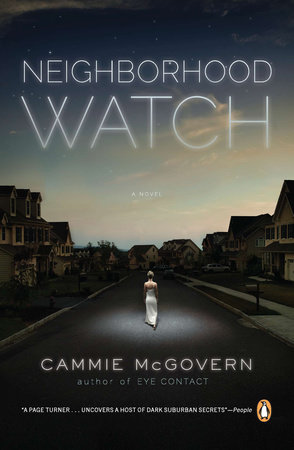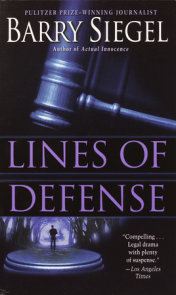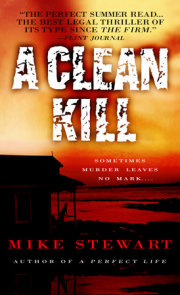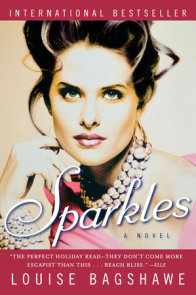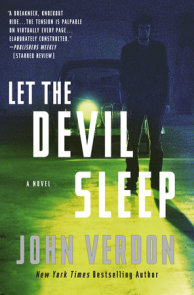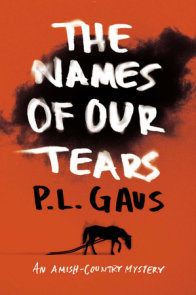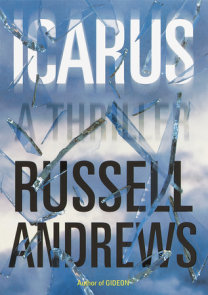READERS GUIDE
Questions and Topics for Discussion
INTRODUCTION
Secrets need safe harbors. They lurk in places you’d expect—laboratories that house controversial experiments, the scenes of brutal murders, inside the minds of those who’ve committed crimes. But secrets also have a tendency to hide in inconspicuous, quiet places. In a marriage that seems perfectly normal. In a house on a typical suburban street. In a garden that just won’t seem to grow. And in the mind of a librarian whose ordinary days belie the memories that disturb her nights. All of these secrets are at the center of Cammie McGovern’s Neighborhood Watch.
For more than a decade, Betsy Treading has been haunted by the secrets surrounding the death of her neighbor, Linda Sue. Scant evidence seemed to implicate Betsy in the murder. Based on her years of severe sleepwalking, she had little trouble believing cops’ scenario and has spent the last twelve years in prison, kept company by a cellmate and her imaginary children—the ones she’s lost in five heartbreaking miscarriages.
When DNA testing finally exonerates Betsy, she finds herself released from one prison and back into another: the stifling suburban street where she lived with her now–ex husband. It’s a different world now, one of cell phones and paranoia, where people she once called friends go out of their way to ignore her. It is a world where, in order to be accepted, Betsy must solve Linda Sue’s murder once and for all. Doing so will require dredging up painful memories and sorting through what really happened on the night of the killing.
As she investigates, Betsy begins to remember more and more about the time leading up to Linda Sue’s death. But other memories also emerge about her horrific childhood and the marriage she now realizes was, much like her quintessentially suburban life, an illusion.
But most of all, Betsy finally unravels the vast web of secrets she and her suburban neighbors have desperately tried to hide for so many years. The reason for Linda Sue’s murder lies in these secrets, as does the identity of the real killer. Even with an ever–watchful eye, secrets are never truly safe—and neither are those who try to keep or uncover them.
ABOUT CAMMIE McGOVERN
Cammie McGovern was a Stegner Fellow at Stanford and received the Nelson Algren Award in short fiction. Her work has been published in Redbook, Seventeen, Glimmer Train, TriQuarterly, and other publications. Her first novel, Eye Contact, is available from Penguin.
A CONVERSATION WITH CAMMIE McGOVERN
Q. Your new novel goes into some pretty complex territory—prison life, sleep disorders, physics. Will you talk a bit about how you went about researching Neighborhood Watch?
Researching ends up being one of the most fun, but also the trickiest parts in writing good suspense fiction, I find. In the past, I’ve tended to overresearch certain subjects and have had a hard time paring down the information which can be incredibly fascinating but also deadly in keeping a suspenseful story going. In this one, I found sleep disorders particularly compelling. There are a surprising number of real cases where sleepwalking has been used as a successful defense in murder cases. The most remarkable might be a Canadian man named Kenneth Parks who, in 1987, with no known history of violence, got in his car, drove fifteen miles, climbed in the window of his in–laws’ house and attacked them both with a lead pipe, ultimately killing the mother–in–law he’d by all reports always been very fond of. He argued that he was sleepwalking the entire time and had no memory of the events. Because he had a well–documented history and genetic predisposition to the condition (his father had also been a sleepwalker) he was eventually acquitted. For my purposes, I was most interested in the idea that a chronic sleepwalker might become terrified of her own subconscious desires and impulses and what was getting acted out in the middle of the night.
Q. How was the experience writing this novel different from that of Eye Contact?
In Eye Contact, I was much more focused on the depiction of the autistic boy who has witnessed a murder at the center of that novel. I was hoping to depict something both true and hopeful about autism and parenting a child with disabilities based on my own experiences raising a son who’s now fourteen and has autism. For that, my research was basically our lives and especially the first six years of his. I was also new at writing a mystery, which I discovered was much harder than I expected it to be. Since then I’ve read so much more throughout the mystery and literary suspense genres that I’ve picked up some tricks which make it no less of a challenge, but also a lot of fun. I feel like this book is plotted with a much surer hand and told with a more intriguing narrative voice.
Q. Do you have experience with the sort of suburban landscape Betsy’s trying to navigate? Why do you think the suburbs make such a great setting?
My sense is that the flourishing of American suburbs gave rise to an emphasis so many of us grew up with: that appearances are important and façades matter. Houses and lawns should look a certain way, as should—by extension—the children and the occupants of those houses. Ostensibly there’s nothing wrong with keeping up appearances, but the desperate attempt to maintain a shiny façade when there are cracks widening to fissures below the surface can be incredibly dangerous, I think.
I’ve always been especially fascinated by the housing developments that pop–up on old farmlands where there are no trees or natural landscaping to integrate the cluster into its environment. They look like an oval of Monopoly houses. Part of me can see the great appeal of these developments—everyone would be equal, with identical houses. Your lives might be a shared reflection of each other’s, almost like the old level playing field of a college dorm. But of course it isn’t really a level playing field and every house on the street might look the same but they all contain secrets. To me, that idea of a cul–de–sac of identical houses, cut off from the outside, felt like a great, pressure–cooker setting.
Q. Who was your favorite character to write? Why? Were any of the characters particularly difficult to create?
I suspect my favorite character to write was Linda Sue, the one who moves onto the block, lets her lawn run wild and says whatever she feels like at the neighborhood gatherings. She speaks the truth, as she sees it, to people who’ve been dancing around it for years. I’ve always secretly loved these people in life—who aren’t afraid of the social awkwardness of ruining a dinner party. In this case, her honesty destroys the pretense the whole neighborhood has carefully constructed for itself and sets in motion the unraveling of everyone’s façade. And, sadly, she pays the ultimate price for it.
Q. Were it not for DNA testing, Betsy would have never been released from prison. What’s your opinion on DNA testing for inmates, especially those on death row? Is the expense justified even if only a fraction of a percent of people are cleared?
Since 1992, new testing on old DNA evidence has freed 254 innocent men and women convicted of crimes they didn’t commit, many of whom had been previously sitting on death row. The Innocence Project, started by Barry Scheck and Peter Neufeld as a clinical course in law school, has now expanded into similar programs in 59 law schools around the country with students getting hands–on experience doing the extraordinary legwork of filing petitions to revisit settled cases and apply for new DNA testing on old evidence. Doing any research into this topic, one quickly realizes there are countless examples to prove that our justice system is composed of human beings who are inherently flawed, and the victims are most likely to be indigent or low–income defendants. After Innocence is an especially moving documentary that would persuade most people that yes, new DNA testing is an essential new tool that is absolutely imperative for cases on death row.
Q. Trish credits Betsy with inspiring her to become a writer. Who are the people in your life who helped you become a successful writer and novelist? What advice do you have for young people—or even older people—hoping to embark on a writing career?
I grew up as the child of two teachers (my father was a law school professor, my mother a high school English teacher). Our house was full of books and even though I was secret a TV addict as a child and not a particularly voracious reader, the effect was still the same—books, and the conversations they inspired, were valued above everything else. My sister was an early inspiration because she was bold and self–confident about wanting to be an actress at a very young age, even when our parents were frantically steering her in other more practical directions. She was also very kind about my writing before I had any discernable talent, but mostly she was an example: That to become an artist takes a certain self–confidence—and not a showy, arrogant one, I don’t think, but a quiet one lodged deep within one’s heart–that this is, very simply, what you want to do. Later, the friend I made in my MFA program and on a Stegner Fellowship at Stanford taught me a lot about how long the journey toward making any kind of living at writing can be and how fraught with ups and downs along the way. We all had little tastes of early success and then long, wintry spells of failure. When I look at who among us is still writing and publishing, it’s not necessarily the ones with the most talent in the beginning, but the ones who rode out the hard years of rejection and kept going.
To anyone, young or old, who wants to start writing, the first step is reading as much and as widely as possible. Teaching at a college level, it becomes abundantly clear: the best student writers, hands down, are the ones who’ve read the most on their own, outside of school assignments. They’ve already developed a passion for certain writers and come to class touching a book jacket tenderly before they read a favorite passage aloud. The effect a lifetime (or even a few years) of avid reading is almost incalculable: you develop a better vocabulary and a more fluid sense of sentence structure, how to vary it, and use paragraphs effectively. Mostly, though, you internalize the components of how to tell a good story—with a beginning, middle and end, mystery along the way, and (hopefully) a conclusion that satisfies.
Q. When you begin constructing a mystery plot, what’s the biggest challenge?
I seem to work in an impractical way. I write (longhand!) a whole bunch of scenes with different possibilities of secrets to be revealed and then find the story around the scenes, characters, and developments that feel the most alive or funny or touching or what have you. For me, this method makes for better writing because I can save only the best and I’ve learned how to cut great volumes of material so I save only the best. But it also means writing three times the number of pages I ultimately end up with. I also confess I have a hard time picking my killers and usually have no idea what the ending is going to be when I begin. It’s such a delicate art because you want it to be a known character, but I’ve always had a problem with the Sunday school teacher introduced in the first third of the book who suddenly and sort of unaccountably turns out to be a psychopath. The violence needs to come from somewhere. In the best mysteries you hope to have flickered little suggestive lights at that place without shining some obvious strobe on it.
Q. Your favorite thriller/mystery authors and influences?
I read an enormous amount from a pretty wide swath of contemporary fiction. I love the dark edges of Tom Perrotta’s humor, along with writers like Jess Walter and Carolyn Parkhurst. For page–turning story ideas, I read Harlan Coben, Laura Lippman, Tana French, and Dennis Lehane. My next book has gothic elements, so I’ve spent this last year reading and loving Sarah Waters, Kate Morten, and Diane Setterfield (books about books and readers! I love them!).
DISCUSSION QUESTIONS







